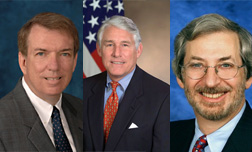SDFM The Business of Defense
-
The Pentagon is aggressively looking for alternatives for fuel. Not only is it a matter of of money, but the Washington Post is reporting that about half of the U.S. military casualties in Iraq and…
April 13, 2009 -
A New Hampshire congresswoman said the Pentagon has failed to justify giving a new, $35 million contract to a company whose electrical work on U.S. facilities in Iraq has been criticized as shoddy and unsafe.…
April 10, 2009 -
Dr. Gerald Cross, Dr. Steven Jones, & Dr. Robert Kolodner The Progress, The Promise, and The Importance of Electronic Health Records and Health Information Sharing to the Delivery of Health Care April 13 & April 15
April 09, 2009 -
Mark Gibson AFGE, Labor Relations Specialist Barbara Palmer Author, \"Breaking the Political Glass Ceiling: Women and Congressional Elections\" Virginia Hemingway President, AFGE DoD Local 2433
April 08, 2009 -
The Obama administration it will participate directly in group talks with Iran over its suspect nuclear program. State Department spokesman Robert Wood said the United States would be at the table “from now on” when…
April 08, 2009 -
The Pentagon is going in a different direction when it comes to the 2010 budget. Secretary Robert Gates will unveil it today. Spokesman Geoff Morrell said the Secretary would spend the weekend working on finishing…
April 03, 2009 -
The number of defense contracting fraud and corruption cases sent by government investigators to prosecutors dropped precipitously under the Bush administration. the Center for Public Integrity reports the decrease took place even as contracting by…
April 02, 2009 -
Amanda Eamich, Director of Strategic Communication and New Media in the Food Safety and Inspection Service at the Agriculture Department talks about how her agency is using Web 2.0 tools to share information internally, to push information out to citizens, and to get feedback from the public.
March 30, 2009 -
Judy Tillman Commissioner, Financial Management Service U.S. Department of the Treasury March 30th & April 1st
March 26, 2009 -
The North Koreans are moving ahead with plans to load a Taepodong rocket on it’s east coast launch pad in aticicpation of launching a satellite early next month. U.S. intelligence officials say Japanese news reports…
March 25, 2009 -
More troops headed to Afghanistan. So to are more contractors, like those that worked at the company formerly known as Blackwater. That company and others involved in excessive force allegations brought about more scrutiny of…
March 23, 2009 -
The Pentagon Budget will be front and center in about a month. Among the programs and issues on the bubble are the Army’s Future Combat systems. The GAO also recommended that Congress not approve full…
March 23, 2009 -
Have DHS’s priorities changed when it comes to the southern border? DHS secretary Janet Napolitano seemed to suggest they have. Meeting with reporters Napolitano said DHS is still focused on fighting illegal immigration and drug…
March 20, 2009 -
Summer in Afghanistan is called “120 days of Wind” by some. But this one may be called “The Long Hot Summer”. Pentagon sources say the war in the southern and eastern parts of the country…
March 16, 2009






